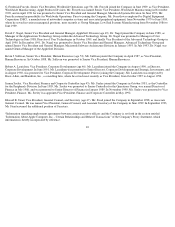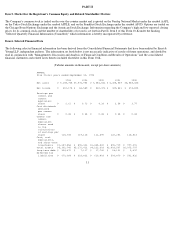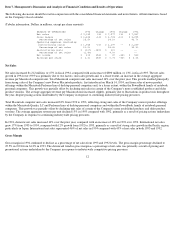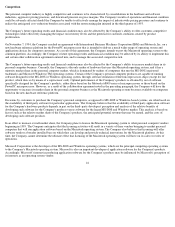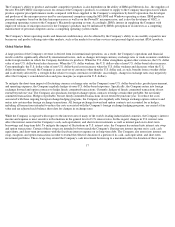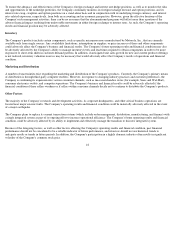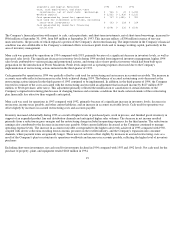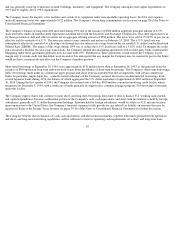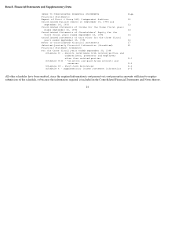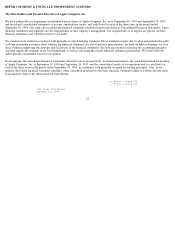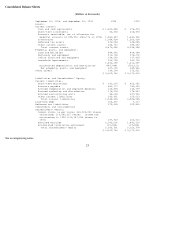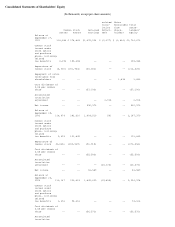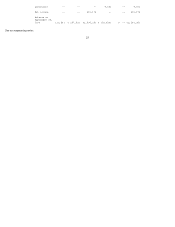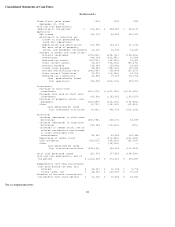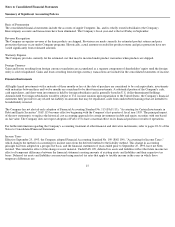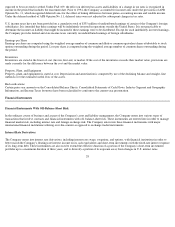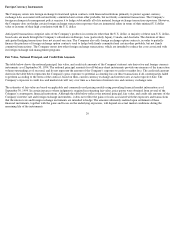Apple 1994 Annual Report Download - page 22
Download and view the complete annual report
Please find page 22 of the 1994 Apple annual report below. You can navigate through the pages in the report by either clicking on the pages listed below, or by using the keyword search tool below to find specific information within the annual report.and was primarily made up of increases in land, buildings, machinery, and equipment. The Company anticipates that capital expenditures in
1995 will be slightly above 1994 expenditures.
The Company leases the majority of its facilities and certain of its equipment under noncancelable operating leases. In 1994, rent expense
under all operating leases was approximately $122 million. The Company's future lease commitments are discussed on page 38 of the Notes to
Consolidated Financial Statements.
The Company's balance of long-term debt increased during 1994 due to the issuance of $300 million aggregate principal amount of 6.5%
unsecured notes under an omnibus shelf registration statement filed with the Securities and Exchange Commission. This shelf registration was
for the registration of debt and other securities for an aggregate offering amount of $500 million. The notes were sold at 99.925% of par, for an
effective yield to maturity of 6.51%. The notes pay interest semi- annually and mature on February 15, 2004. The 6.51% fixed-rate was
subsequently effectively converted to a floating-rate through ten-year interest rate swaps based on the six-month U.S. dollar London Interbank
Offered Rate (LIBOR). The impact of the swaps during 1994 was to reduce the 6.51% fixed-rate yield to a 5.62% yield. To mitigate the credit
risk associated with these ten-year swap transactions, the Company entered into margining agreements with its third-party bank counterparties.
Margining under these agreements generally does not start until 1997. Furthermore, these agreements would require the Company to post
margin only if certain credit risk thresholds were exceeded. It is anticipated that any margin the Company may be required to post in the future
would not have a material adverse effect on the Company's liquidity position.
Short-term borrowings at September 30, 1994, were approximately $531 million lower than at September 24, 1993, as the proceeds from the
issuance of $300 million in long-term debt were used to pay down the balance of short-term borrowings. The Company's short-
term borrowings
reflect borrowings made under its commercial paper program and short-term uncommitted bid-line arrangements with certain commercial
banks. In particular, Apple Japan, Inc., a wholly owned subsidiary of the Company, incurred short-term yen-denominated borrowings from
several Japanese banks during 1994, the balance of which aggregated the U.S. dollar equivalent of approximately $202 million at September
30, 1994. During the first quarter of 1994, the Company also entered into a 364-day $500 million committed revolving credit facility which
terminated on December 8, 1994, with a syndicate of banks primarily in support of its commercial paper program. No borrowings were made
under this facility.
The Company expects that it will continue to incur short- and long-term borrowings from time to time to finance U.S. working capital needs
and capital expenditures, because a substantial portion of the Company's cash, cash equivalents, and short-term investments is held by foreign
subsidiaries, generally in U.S. dollar-denominated holdings. Amounts held by foreign subsidiaries would be subject to U.S. income taxation
upon repatriation to the United States; the Company's financial statements fully provide for any related tax liability on amounts that may be
repatriated. Refer to the Income Taxes footnote on pages 35-36 of the Notes to Consolidated Financial Statements for further discussion.
The Company believes that its balances of cash, cash equivalents, and short-term investments, together with funds generated from operations
and short- and long-term borrowing capabilities, will be sufficient to meet its operating cash requirements on a short- and long-term basis.
20


